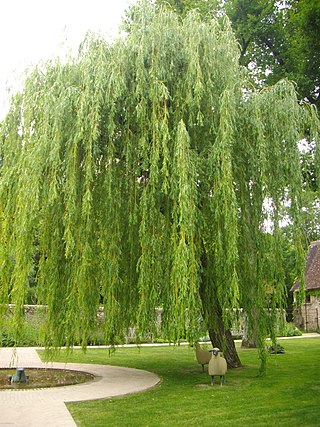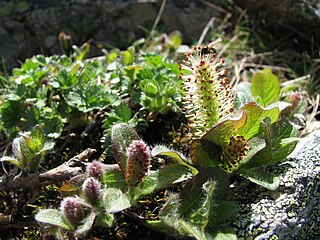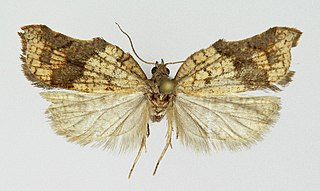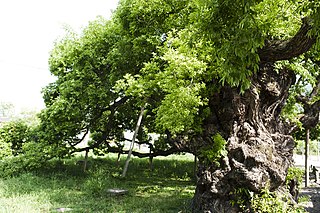
Willows, also called sallows and osiers, of the genus Salix, comprise around 350 species of typically deciduous trees and shrubs, found primarily on moist soils in cold and temperate regions.

Futura is a geometric sans-serif typeface designed by Paul Renner and released in 1927. It was designed as a contribution on the New Frankfurt-project. It is based on geometric shapes, especially the circle, similar in spirit to the Bauhaus design style of the period. It was developed as a typeface by the Bauer Type Foundry, in competition with Ludwig & Mayer's seminal Erbar typeface of 1926.

Leonard Hilton McGurr, known as Futura, and formerly known as Futura 2000, is an American graffiti artist.

Salix alba, the white willow, is a species of willow native to Europe and western and central Asia. The name derives from the white tone to the undersides of the leaves.

Salix caprea, known as goat willow, pussy willow or great sallow, is a common species of willow native to Europe and western and central Asia.

MIPIM is an international property event hosted in Cannes, France, each March. It is hosted by Reed MIDEM and includes an exhibition area, networking events and conference sessions over four days. The 2023 event took place from 12th to 15th March.

Salix babylonica is a species of willow native to dry areas of northern China, but cultivated for millennia elsewhere in Asia, being traded along the Silk Road to southwest Asia and Europe.

The grey dagger is a moth of the family Noctuidae.

Salix cinerea is a species of willow native to Europe and western Asia.
Salix serissaefolia is a putative species of willow native to central Japan. It is known as コゴメヤナギ in Japanese. It was described by Kimura in Bot. Mag. Tokyo40: 639 (1926). H.Ohashi synonymized it as Salix jessoesis subsp. serissaefolia (Kimura) H. Ohashi, comb. nov., in A Systematic Enumeration of Japanese Salix (Salicaceae), Hiroyoshi OHASHI 植物研究雑誌 J. Jpn. Bot.75: 1-4 1 (2000). Note the typographical error for Salix jessoensis. Salix jessoensis is a synonym of Salix pierotii, as is Salix serissifolia. Note the spelling difference between Salix serissaefolia and Salix serissifolia.

Salix nakamurana is a rare species of willow native to alpine slopes of central Japan. It is a deciduous small prostrate shrub.

Salix japonica is a species of willow native to hills and mountains of central Honshū, Japan. It is a deciduous shrub, reaching a height of 2 m.

The Suzuki Carry is a kei truck produced by the Japanese automaker Suzuki. The microvan version was originally called the Carry van until 1982 when the passenger van versions were renamed as the Suzuki Every. In Japan, the Carry and Every are kei cars but the Suzuki Every Plus, the bigger version of Every, had a longer bonnet for safety purposes and a larger 1.3-liter 86-hp (63 kW) four-cylinder engine. They have been sold under myriad different names in several countries, including those with Chevrolet and Ford badges.

Salix OS is a multi-purpose Linux distribution based on Slackware.

Lithophane socia, the pale pinion, is a moth of the family Noctuidae. The species was first described by Johann Siegfried Hufnagel in 1766. It is found throughout western Europe from Spain to central Scandinavia then east across the Palearctic to Siberia, the Russian Far East and Japan.

Orthosia gracilis, the powdered Quaker, is a moth of the family Noctuidae. It is found in all of Europe except the extreme north and south, then east across the Palearctic to Northern Asia and Central Asia. O. g. pallidior is described from Xinjiang in China.

Leucoptera sinuella is a moth in the Lyonetiidae family. It is found in most of Europe, except Ireland, the Balkan Peninsula and the Mediterranean Islands. It is also found in Japan and North Africa.

Acleris effractana, the hook-winged tortrix moth, is a moth of the family Tortricidae. It was described by Jacob Hübner in 1799. It has a Holarctic distribution. In Europe, it is found from northern Europe to the northern part of central Europe. It is also present in north-western Russia, Japan, Canada and the northwestern United States.

Salix pierotii, the Korean willow, is a species of willow native to northeast China, far eastern Russia, the Korean peninsula and Japan. They are shrubs or trees reaching 8 m. Because their twisted wood is not good for timber or making tools, in Japan Salix pierotii trees are used to demarcate property lines between farms.


















